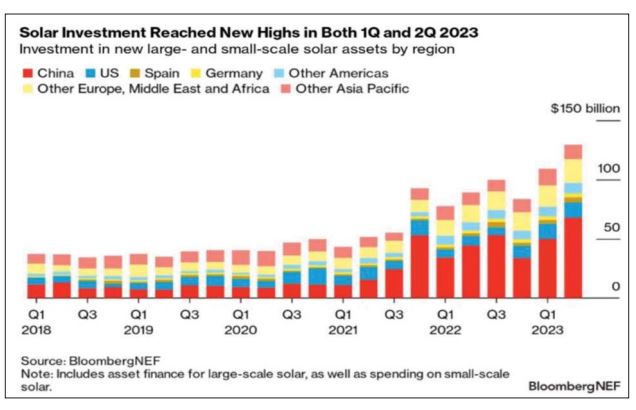Copper, one of the most important industrial metals, always moves in a way that mirrors the direction of the economic cycle. Since the property crisis devastated China’s real estate sector, the demand for the metal has been dismal. As China is a major industrial economy and the largest consumer of copper, the crisis-affected property sector’s sluggish demand has put pressure on its prices. Despite the economic turbulence and challenges in recent months, copper prices steadily hover above pre-pandemic levels owing to higher demand from the green energy space and electric vehicle sector. Copper is the ideal metal for energy efficiency due to its inherent properties of conductivity, ductility, efficiency, and recyclability. The metal’s electric and thermal properties also ensure that the power grid works at full capacity.
Advanced economies are transitioning from fossil fuels to renewable energy sources. The investments in the green energy sectors have increased tremendously, even though majority of these players are still working towards this goal. According to a Bloomberg report, in the first half of 2023 global new investment in renewable energy soared to USD358 billion, an all-time high for any six-month period and a 22 percent increase from the beginning of the previous year.

The stellar H1-2023 results were primarily driven by solar. During the first half of the year, USD239 billion was invested in both large and small-scale systems, accounting for two-thirds of all global investments in renewable energy. This represents a startling 43 percent increase from the first half of 2022.

China’s ambition to become a global leader in the production of clean energy is going to be a major factor in supporting copper prices. With several years of investments and favorable government policies, China is transforming itself from one of the most polluting countries to becoming a global leader in green energy. However, China’s increased use of coal for power generation as a result of a greater demand for energy has returned the country to the position of one of the most polluting nations.
China has built 210GW of solar energy capacity until September this year, meeting its 2023 targets for wind and solar installations. That is four times what China added in 2020 and twice as much as the United States. China’s installed wind and solar capacity exceeds 820GW, which is 31 percent of total power generation capacity. The authorities had set a target of expanding the installed solar and wind power capacity to over 1,200 GW by 2030.
Forecasts from the Energy Information Administration indicate that in the US, solar energy will generate 14% more electricity than hydroelectric plants by 2024. For the first time, the US’ monthly production of solar electricity surpassed that of hydroelectricity in September 2022. During that month, US hydropower plants produced 17 billion kWh, while US solar power plants and rooftop solar produced roughly 19 billion kWh. The installed solar capacity increased rapidly last summer, pushing solar power over hydropower once again. Installed solar capacity expanded at an average annual rate of 44 percent between 2009 and 2022, while installed hydroelectric capacity increased by less than 1 percent annually during that same period. The yearly generation of solar energy is expected to surpass that of hydropower for the first time in 2024. Both the US solar and wind energy industries are showing similar trends, primarily as a result of increasing installed capacity.
Growth in the capacity of renewable energy in US has been encouraged by incentives like investments tax credits. More than 125 gigawatts (GW) of installed solar capacity were in place in the US as of August 2023. This amount included 80 GW of utility-scale solar capacity and an estimated 45 GW of small-scale solar capacity. For the past few decades, the hydroelectric capacity in the US has stayed comparatively constant at 80 GW.
In an effort to hasten Europe’s shift to green energy from fossil fuels, the European Union lawmakers have approved a deal to increase the share of renewable energy in the bloc’s energy mix. The bill, which was approved by a big majority of lawmakers, has revised the target for renewable energy to a minimum share of 42.5% of by 2030, with the aim of reaching 45%.
Global sales of electric vehicles are still growing, with China reporting record monthly sales in October, even after the removal of subsidies. China ended its 11-year subsidy scheme for the purchase of electric vehicles in 2022. However, in order to attract customers, certain local authorities continue to offer subsidies or tax rebates. October saw a 29 percent year-over-date growth in sales of electric vehicles in China, the largest auto market in the world. In China, auto sales typically peak in the last two months of the year. The global EV market expanded by 34% in the same period of time. During this period, EV sales in North America increased by 78%, while EV sales in European markets grew by 26%.
Although the global economic outlook is challenging for the next year, an expected improvement in manufacturing activity and the ongoing energy transition should support higher growth of refined copper usage in 2024 around the world.







